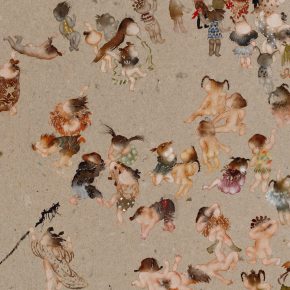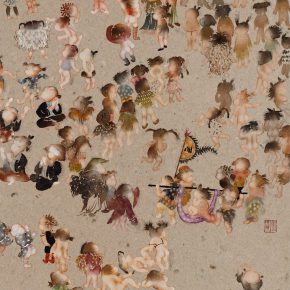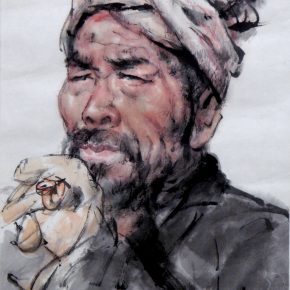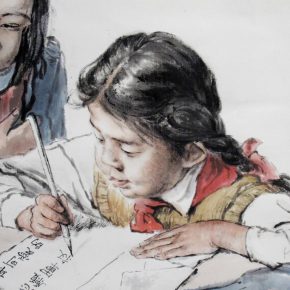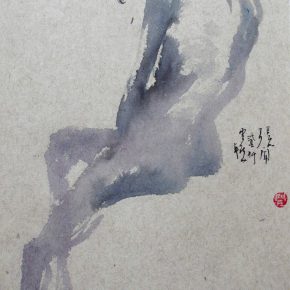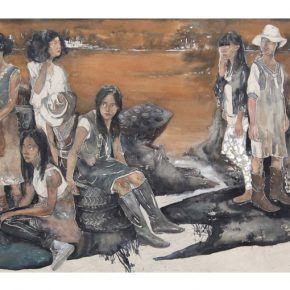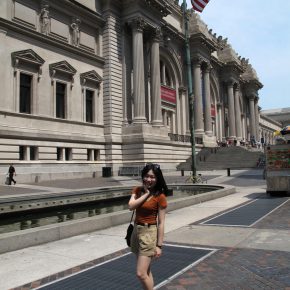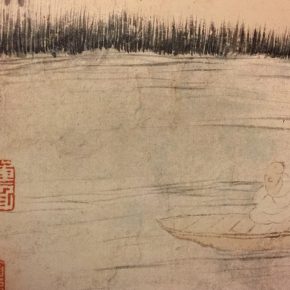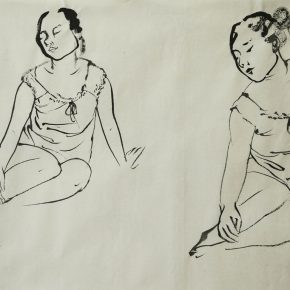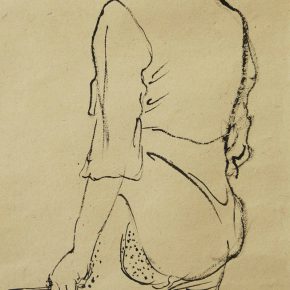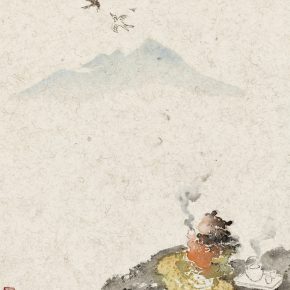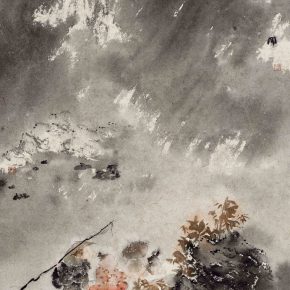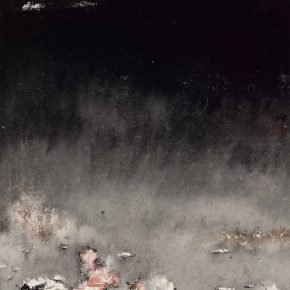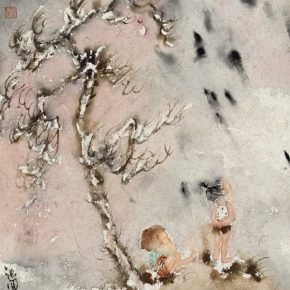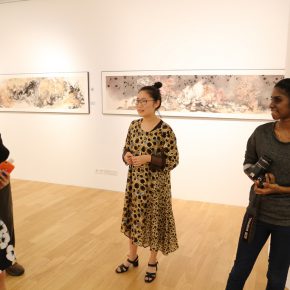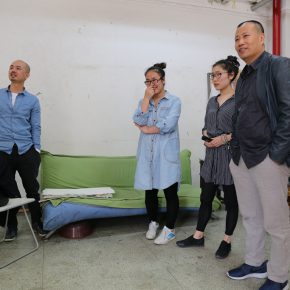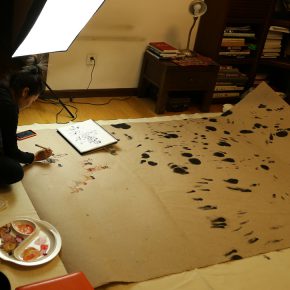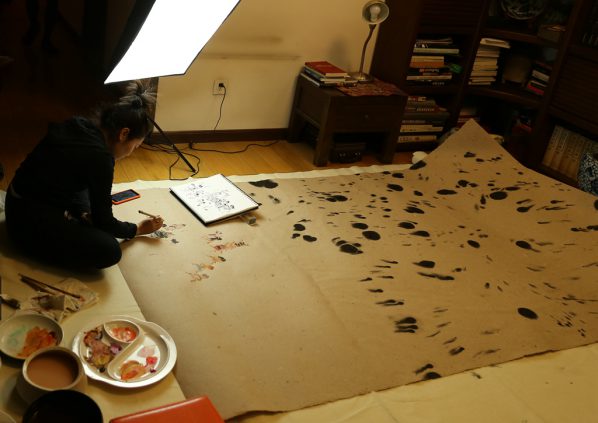
Chinese painting is an ancient expressive form of painting which includes the Chinese spirit and wisdom, and especially the literati painting which centered on freehand, expressing the thoughts, character and wisdom of the painters who were playing with ink and water, in fact, brush and ink is actually mental creation. One can’t be trained to be an artist of Chinese painting without growing up through edification, so I am interested in the growing trajectory of the students from the School of Chinese Painting and I choose the graduate of the year Zhang Wen as the person for observation.
Born in a Family of Painters, Zhang Wen Once Rebelled and Gave Up Chinese PaintingZhang Wen’s father was one of the students who were first admitted to the Central Academy of Craft Art when the college entrance exam was reinstated after the end of Cultural Revolution in 1977, and he learned from Wu Guanzhong. After graduation, he was assigned to a publishing house, and then he taught in the School of Art and Design at Beijing Institute of Fashion Technology. Zhang Wen’s father was once an art editor, manually finishing illustrations, layouts andartistic calligraphy during the period when there were no computers and the design software such as Photoshop as a child this enlightened her to be engaged in art. Affected by the family, Zhang Wen also naturally became the“Commissary in Charge of Publicity” in her school days, mainly in charge of the publishing of the blackboard newspaper and her work was highly praised by the teachers and students, so the painting skills brought her a sense of honor and sense of accomplishment. Therefore, Zhang Wen often feels that, “You are chosen by the specialty rather than you choose a specialty”.
Although her father has been engaged in the creation of Chinese painting, but it is the art teacher of the high school Yu Yanling who guided her onto the path for Chinese painting. Zhang Wen studied in the High School Affiliated to Central Academy of Craft Art and also participated in courses in fine arts in addition to cultural courses. Following various art subjects, Zhang Wen was good at sketching, especially linear sketches, so that her teacher suggested she register for the exam in the specialty of Chinese Painting at CAFA, because Chinese painting pays attention to shaping using a line, which was her advantage. Finally, she succeeded in passing the exam and became the national champion of the sketching exam and she was admitted to the School of Chinese Painting at CAFA , she selected the specialty of freehand figure, Liu Qinghe was the counsellor when she was an undergraduate and then her postgraduate tutor.
During the period of the study in the academy, Zhang Wen was puzzled and thought that Chinese painting was too “old”, whether it suited her temperament or not? The colors of traditional Chinese painting were scant, while the images were weak in performance and visual stimulation, and she even wanted to “go out” of Chinese painting, so she went overseas to study in an art school in the USA after graduation. During the period of learning in the United States, along with an in-depth understanding, she found the present art education in the USA was different from what she imagined, and the “Chinese ink” was more suitable to her. Then she began visiting Rhode Island School of Design and School of the Arts at Columbia University, etc., to attend classes for free, listening to lectures, participating in the student exchange activities, and visited the world-famous art museums such as the Metropolitan Museum of Art, the Guggenheim Museum and MOMA, where she benefited so much. Through the study tour, her artistic vision was opened up and it was more important that she used the distance between Chinese and Western art to deepen the understanding of traditional Chinese painting, which strengthened the determination to return to China and continue to be engaged in the learning and creation of ink painting.
The Material Primary Character is Very Important for Ink PaintingZhang Wen is particularly fond of the small figures decorating the scenes in the landscape painting of the Song and Yuan Dynasties, perhaps boating in the river, or boiling wine in the hut, or walking in the foothills, concisely drawing several strokes to fully express the rich life situation of the Chinese literati, she thinks those figures exude a carefree and leisurely temperament making the whole scene extremely lively. Zhang Wen does not think about the figures without any emotion and being in a daze is a waste of life, and on the contrary, it is necessary for the literati to have this state of mind, which she envies. It seems that the quiet, indifferent, simple but elegant state also corresponds to the common ethos of the students of Chinese painting.
Seen from her practicing experience, the material primary character is paramount and some subject matters, content and expressive ways match the expression of ink material themselves, while some subject matters do not match the expression of ink, if one forcibly uses ink to perform them, they will be abrupt and unnatural. Ink painting is more suitable for the expression of a mood, state of mind or artistic concept. Speaking of the various new forms of contemporary ink art, Zhang Wen thinks it is a natural development, corresponding to the cultural environment in the new era, but if one blindly pursues “newness”, there will be a“superficial” risk, and it is necessary for the young artists to avoid ignoring the relationship with ink painting, but simply focusing on the visual innovation and novelty, deliberately grafting a spiritual thing…
Zhang Wen’s postgraduate thesis is the observation and research of the phenomenon of contemporary ink painting called the “Dark Ink Painting”, and she observes that there is currently a type of painting, centered on the contrast with a large block of ink, and the screen effect of the works showcases a deep dark temperament, which are preferred by many outstanding artists. The screen of these works naturally reveals a deserted and cold feeling. She tried to disassemble and place the term of “dark style” in the context of contemporary ink painting, based on her own understanding and thinking, through classification to analyze this style of artwork, in order to carefully offer a viewing angle to grasp the phenomenon of contemporary ink. She believes that traditional Chinese ink painting is the pursuit of a “deserted and cold” aesthetic charm, achieved through the use of “blank”, but the “dark style” treats black as blank, which is only a conversation of the performance, in fact, it is essentially the return of the spirit of traditional Chinese painting; at the same time, the “dark style” is also influenced by Western art, such as northern Renaissance represented by Bosch and German Neo-Expressionism; in addition, this style is the spiritual aspiration of the times, the focus on society is replaced by the focus on the individual, which is the characteristic of the times, and it is an important trend in terms of artisticcreation.
“Insight” Formula Growth of InkIn the process of Zhang Wen’s artistic growth, it is undoubted that she is profoundly influenced by Liu Qinghe. Speaking of their relationships between the student and teacher over the years, Zhang Wen was moved and filled with gratitude to Liu Qinghe. Liu’s teaching focuses on spiritual enlightenment, sometimes even directed towards the essence and core of the problem when they are chatting, the seemingly metaphysical guidance is particularly valuable, which abstractly guides the students at different stages to slowly comprehend and understand it in practice and students often have more rewards. Liu Qinghe specially wrote a recommendation letter for Zhang Wen, when he had known CAFA ART INFO selected Zhang Wen as a case observation. He writes that, Zhang Wen owns both the basic skill and creativity, and the diligent thinking helps Zhang Wen stand out from the artists of the same age. From the stage of undergraduate to postgraduate, Zhang Wen can accurately grasp the relationship between teaching and personal feelings, and she has finished a number of impressive pieces of work.
Zhang Wen’s graduation creation is a three-square-meter ink painting “One Hundred Children Figure”, which is the extension of the theme of “children” that she has a lot of experience with during the three-year postgraduate creative practice, performing with a group of children stargazing, the lower half of the screen presents more than 400 images of different characters, the starry sky of the screen is portrayed in the form of abstract ink dots, to create the spatial sense of movement, also opening the spectator’s rich imagination, while the title is named the “World”, the open theme also releases more possibilities of interpretation for the audience.
Zhang Wen determines to be a professional artist after graduation, devoting herself to creation for a period of time, although the current art ecology is in the doldrums, Zhang Wen seems to be relatively calm, she said it made her more determined to adhere to her own ideal and aspirations.
Image Courtesy of Zhang Wen
Text by Zhang Wenzhi, translated by Chen Peihua and edited by Sue/CAFA ART INFO




